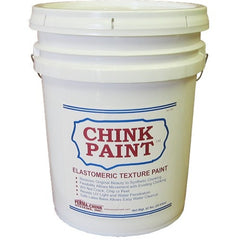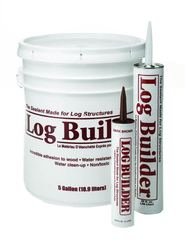Caulking vs chinking. When to use caulk vs chinking on a log home.
Chinking and caulking your log cabin are arguably the most important step in ensuring that your log cabin lasts. Chinking and caulking, protect your logs from decay and insects that can infect your log home. Many people get confused with the difference between caulking and chinking. So let’s check it out.
The main difference between chinking and caulking is texture and elasticity. Caulking is more elastic than chinking and has no texture or very light texture; while chinking comes in various colors or textures. Due to higher elasticity caulking is a great option for using it in smaller joints (i.e. ¼” to 2” wide).
What is chinking used for?
Chinking is used to seal joints between the logs to protect the house from early damage, though thanks to its various textures it also has a decorative function. Chinking products can be used on both the interior and exterior sides of your log house.
It’s highly important to use chinking compatible on a chemical level with the stain, preservative or other products you apply to your logs. That is why it’s always good to use the products from the same manufacturer. Most chinking products are acrylic-based. Here’s an overview of chinking brands you can find in our store.



Chinking as a process is not that complicated as it may seem. You can find a full review of chinking methods and tools in our recent article.
What is caulk and when to use it.
There are a few types of caulking, but the ones that are used in the log home industry are usually acrylic (water-based) or urethane-based. Here is the same as with chinking: make sure that you use products compatible on a chemical level and on application tools, so that you have good adhesion and your sealant remains for a long time.
Why use acrylic caulking?
If you look for an eco-friendly solution for your home then acrylic caulking is worth considering because urethane-based caulking may carry a toxic odor. Make sure that the weather is good when you apply caulk. If it rains within one to four hours after application it may not adhere well. And vice versa, if it’s really hot it dries quickly and may be hard to apply.
What’s the best temperature for caulking?
Caulking works best if applied when the temperature is between 40 and 90 degrees. But don’t get afraid, if you want to remove some of the parts, just simply use water. So plan your sealing beforehand to take into account all these weather nuances.
Why use urethane-base caulks?
Urethane-based caulking is not that weather dependent. In contrary, some rain after applying can even help caulking to skin over and set up. Due to its chemical formula, it’s more resistant to pests and serves both in cold and high temperatures compared to water-based caulking. If you make any flaws while applying, use mineral spirits for clean-up.
If you want to bring some colors to your interior, it's better to use urethane-based since it can be painted, stained or sanded over; while paint on water-based caulking is likely to not adhere.
Have a look at the caulking products we offer in our store.


As always if you have any questions feel free to give us a call. Also if you have any tips or ticks when it comes to chinking or caulking, feel free to comment below!

Thank you for your inquiry. If you space your boards apart you could put Log Jam chinking in between the boards for the look of mortar. It would differently give you a rustic look. You can view this on our online store at www.iwoodc.com or feel free to call us at 1-800-721-7715 and we would be happy to help you!
Sincerely,
I-Wood-Care